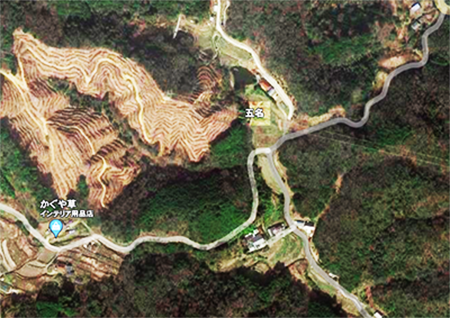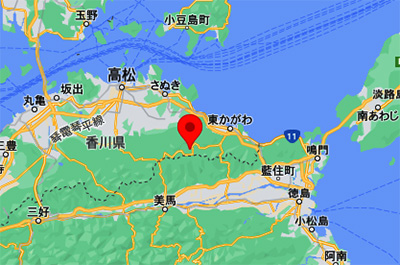

いまから200年以上前の東讃岐の平均的な山村農家。
寄棟造・茅葺きの11坪というコンパクト住宅です。
「周囲〜ぐるり〜八間」と一般的に呼ばれた庶民の家という。
一般呼称の「ぐるり八間」というのはやや自虐的な愛称のように響く。
「ウチは〜ほどのちっちゃな家だから(笑)」みたいな名付けか。
3間四方の基本骨格9坪に下屋で2坪分取り込んだ建て方か。
多少の平面的凹凸があって11坪という面積だけれど
いかにも日本的な合理主義の所産のような間取り。
必要最小限の床面積の空間にくらしのすべての要素を満たす住宅。
下屋部分にまで茅葺き屋根が葺き下ろされている。
屋根の棟部分に「抑え」として雁ぶり〜がんぶり〜瓦。
また棟中央には同じ茅葺きの「煙出し」が設けてある。
香川県指定有形文化財として四国村に移築保存されているけれど、
移築前は、香川県大川郡白鳥町五名1840という地番で
(現在は東かがわ市)写真のようなGoogle Map。


四国は平野部が少なく、山林を切り開いて農地化させた地形が多い。
地形写真を見るとそのような典型的山村の農家のようです。
屋根の形状がその暮らし方を表現しているかのようで、
つつましく勤勉に生活する価値感が匂い立っている。
いかにも日本人の原風景的な住まいのありようではないかと思われた。
こういう住宅をしっかり保存されている四国村の生活文化記録者に
たしかな住宅選択眼を感じさせられた。
歴史的に名を残した人物の住宅も貴重な「消息」を伝えてくれるけれど
一方で名も無い庶民の家々には民俗そのものが凝縮される。
古民家でも庄屋階層などの上農の家ばかりではなく庶民の家は
その明瞭な暮らしの証言性で胸に迫ってくるものがある。

こちらの写真は「懸け魚」といわれる地域の正月飾り。
まんなかの魚は「アラ」とおぼしいのだけれど、
大事に衣装を着させられていてなんともかわいらしい。
左右には大根、ニンジン、カブが整然と吊り下げられている。
山村での暮らしで、魚は非日常的な「ご馳走」として
振り売りの手で各戸に訪問販売されて、このように特別な正月縁起ものに
昇格して飾り立てられたものでしょう。
このように吊しておいて正月期間の経過後、
これらを鍋料理に仕立てて一家で食べたように思えます。
正月の間は家の先祖霊や神さまに供えて、その後
家族がそれらを囲んで食事するという風景が見えてくる。
日常と非日常、ハレとケの暮らしぶりが
日本人としての生活規範そのものを証言しているのでしょう。
English version⬇
[Higashi Sanuki “Gururi Hachima” mountain village Minka ① Shikoku Living Space Exploration-35]
A compact house in the Edo period desperate to live. Did you open up slopes in the mountains and steadily farm, and did you inspire “hanging fish” during the New Year?・ ・ ・
The average mountain village farmer in Higashi Sanuki more than 200 years ago.
It is a compact house with a hipped roof and thatched roof of 11 tsubo.
It is called the house of the common people, which is generally called “Around-Gururi-Hachima”.
The general name “Gururi Hachima” sounds like a self-deprecating nickname.
Is it a name like “I’m such a small house (laughs)”?
Is it a construction method that incorporates 2 tsubo in a lower house with a basic skeleton of 9 tsubo on all sides of 3 ken?
There are some flat irregularities and the area is 11 tsubo.
The floor plan is like the product of Japanese rationalism.
A house that meets all the elements of living in a space with the minimum floor area required.
A thatched roof is laid down to the lower part.
Goose-buri-ganburi-roof tiles as a “suppression” on the roof ridge.
In addition, the same thatched “smoke” is installed in the center of the building.
Although it was relocated and preserved in Shikoku Village as a tangible cultural property designated by Kagawa Prefecture,
Before the relocation, the lot number was 1840, Gomyo, Shirotori-cho, Okawa-gun, Kagawa Prefecture.
(Currently Higashikagawa City) Google Map like the picture.
Shikoku has few plains, and there are many terrains that have been carved out of forests and turned into agricultural land.
Looking at the topographical photographs, it looks like a typical mountain village farmhouse.
The shape of the roof seems to express the way of life,
The value of living humble and diligent is scented.
It seemed like the original Japanese dwelling.
To the life culture recorder of Shikoku village where such a house is well preserved
It made me feel a certain eye for choosing a house.
The house of a person who has left a name in history also conveys a valuable “news”.
On the other hand, the folklore itself is condensed in the houses of the unnamed ordinary people.
Even in old folk houses, not only the upper farming houses such as the Shoya level but also the common people’s houses
There is something that comes to my heart with the clear testimony of life.
This picture is a New Year’s decoration in the area called “hanging fish”.
The fish in the middle seems to be “ara”, but
It’s so cute that she’s dressed carefully.
Radishes, carrots and turnips are neatly hung on the left and right.
Living in a mountain village, fish is an extraordinary “feast”
Door-to-door sales are made to each house by hand, making it a special New Year’s lucky charm.
It must have been promoted and decorated.
After hanging like this and after the New Year period has passed,
It seems that these were made into hot pot dishes and ate at home.
Offer to the ancestral spirits and gods of the house during the New Year, and then
You can see the scenery of the family surrounding them and eating.
Everyday and extraordinary, the way of life of hare and ke
Perhaps it is a testimony of the norms of life as a Japanese.
Posted on 3月 29th, 2022 by 三木 奎吾
Filed under: 住宅マーケティング, 日本社会・文化研究







コメントを投稿
「※誹謗中傷や、悪意のある書き込み、営利目的などのコメントを防ぐために、投稿された全てのコメントは一時的に保留されますのでご了承ください。」
You must be logged in to post a comment.